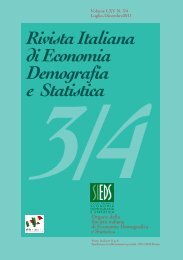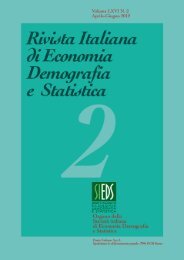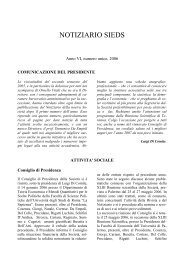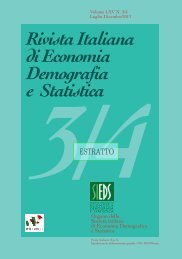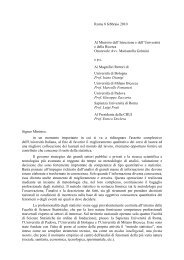rivista italiana di economia demografia e statistica - Sieds
rivista italiana di economia demografia e statistica - Sieds
rivista italiana di economia demografia e statistica - Sieds
You also want an ePaper? Increase the reach of your titles
YUMPU automatically turns print PDFs into web optimized ePapers that Google loves.
Rivista Italiana <strong>di</strong> Economia Demografia e Statistica 165<br />
like leisure or sport clubs. The subjective perceptions of social exclusion and of<br />
social usefulness are captured by the EB questions: “Do you feel left out of<br />
society?” and “Do you feel to have the chance to play a useful part in society?”.<br />
Finally, for the institutional <strong>di</strong>mension, the EB survey provides data about the<br />
subjective evaluation and satisfaction of the respondents about the me<strong>di</strong>cal services,<br />
their social entitlements in case of sickness, invali<strong>di</strong>ty and unemployment, and the<br />
presence of vandalism and theft in the place where they live.<br />
In Latent Class models, covariates are used to pre<strong>di</strong>ct the membership to latent<br />
classes, thus improving their description. The in<strong>di</strong>vidual level covariates we used<br />
are the age and the occupational status of the respondents. Referring to the regional<br />
level covariates, we considered the gross domestic product (GDP), and we defined<br />
an in<strong>di</strong>cator given by the ratio between the amount of taxes, social contribution and<br />
transfers paid, and the primary income, representing a proxy of the social<br />
protection expen<strong>di</strong>ture of the region. Finally, using an in<strong>di</strong>vidual response of<br />
Eurobarometer, we computed an in<strong>di</strong>cator that quantifies, for each European region,<br />
the percentage of people attributing the responsibility of poverty and social<br />
exclusion either to in<strong>di</strong>vidual or to societal failure.<br />
3. A multilevel latent class model to study social exclusion<br />
We analyse the con<strong>di</strong>tion of social exclusion for the in<strong>di</strong>viduals. However,<br />
sharing the same environmental con<strong>di</strong>tions, in<strong>di</strong>viduals within a region tend to be<br />
more alike than in<strong>di</strong>viduals coming from <strong>di</strong>fferent regions. The approach followed<br />
to deal with the intra-region correlation is the so-called multilevel approach<br />
(Skrondal and Rabe-Hesketh 2004). First level units are in<strong>di</strong>viduals, and the first<br />
level model corresponds to a standard LC analysis (Hagenaars and McCutcheon<br />
2002). Based on the observed in<strong>di</strong>cators, in<strong>di</strong>viduals are classified in latent classes,<br />
representing the levels of exclusion. The regions where in<strong>di</strong>viduals live represent<br />
the second level units: the regional <strong>di</strong>fferences in the <strong>di</strong>stribution of the latent<br />
variable are modelled allowing some parameters to vary across regions.<br />
Consider in<strong>di</strong>viduals i= 1,..., nj<br />
originated from an international sample of 77<br />
European regions, j = 1,...,77 . Y<br />
ijk<br />
represents the response to item k (with<br />
k = 1,...,12<br />
) of person i coming from region j , whereas Y ij<br />
is the full K × 1<br />
n × K × vector<br />
Y is the full ( ) 1<br />
vector of responses of the same in<strong>di</strong>vidual i , and<br />
j<br />
j<br />
of responses of all in<strong>di</strong>viduals in region j . All the K = 12 in<strong>di</strong>cators used in the<br />
analysis are categorical. Z ij<br />
and<br />
g<br />
Z denote respectively the in<strong>di</strong>vidual and the<br />
j



